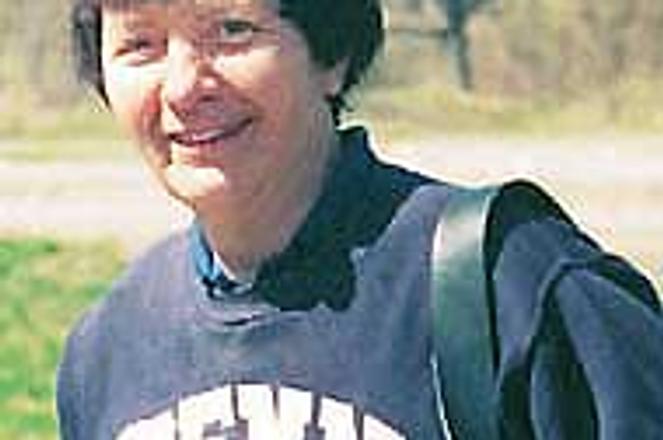photo: Courtesy of Lil Junas
ON HER day off, she would take a bike or a bus and travel around the country. As an American, she would have problems with putting the right endings on words when talking to locals. But she would photograph everything and take a pile of notes. Her Slovak friends would call her the "travelling American", and worry about her for never knowing where she was.
"But that's how I got to know the local people," says Lil Junas, an American photojournalist in her fifties, whose grandparents, on both sides of her family, came from Slovakia.
Junas recorded her observations of Slovakia in her recently issued book My Slovakia, selling both here and in the US. In 56 pages, Junas offers an introspective view of Slovakia's history, traditions, lifestyle and countryside through the eyes of an American. Alongside the factual text she runs anecdotes reflecting her childhood and recent experiences with Slovaks and their customs.
With Junas ever ready with her camera, one of the 78 colour photographs in the book even captures the driver of a horse-drawn wagon carrying four people who jumped down and poured Junas the first glass of wine she was ever offered on a road. The Slovaks were returning from their gardens, and the man spontaneously decided to share his home-made wine with her.
"That was pure hospitality. It likely wouldn't happen in the US," she says.
She has worked in journalism for over 20 years. Currently she teaches journalism at Wartburg College in Iowa, and every second year she takes her students to Slovakia for a month, to compare the Slovak local media with theirs.
"Being that I'm a photojournalist, I always have ideas about writing and photographing every place I go."
Junas grew up in a largely Slovak neighbourhood in north-east Pennsylvania. Her Slovak grandparents came to America as teenagers in 1880s to work in the coal mines. It was not until the fall of communism that Junas set foot in her ancestral homeland.
It was not her Slovak roots, though, that brought her here, as is the case with many North Americans of European descent. As a volunteer with Education for Democracy, a teaching association started by a Slovak, she signed a contract in 1992 along with 80 other Americans to teach English in Slovakia for four months.
As the term advanced, she decided to stay longer. The customs she practised back in her American home, the food she ate and the words she heard, finally started to make sense. Meeting her blood relatives from her father's side was a revelation, she says.
"None of my relatives in America ever knew about my relatives from the Junas side. And here I am, sitting in their kitchen, and they are bringing out papers and pictures of people that I know. I was thinking to myself, I must be in the right house! I recognise my grandfather in a picture, and out comes the slivovica [home made plum brandy]. I have one drink. But then I point to another photo, to my father's sister, and here comes another shot. That was when I first realised that I was part of this heritage," says Junas.
Having brought piles of notes back home, she compiled them into a small booklet on her home computer.
JUNAS's pictures reflect everyday life in Slovakia seen through American eyes.photo: Lil Junas
"I did it for my family, for reunions, but since people liked it so much I made more copies and people started buying it from me," she says. During that period, she also compiled a 24-page guide to Slovakia.
Discovering that people were interested in the publications, she continued coming to Slovakia and collecting notes for a longer book. Even though she did it mostly to sell in America, she thought it could be a good keepsake for foreigners coming to Slovakia, as it is in English, and also for Slovaks who speak English, as they could see how foreigners reacted to their customs and lifestyles.
"Some of my colleagues were offended that Lil was photographing old things and old people. But I like the book a lot. I saw myself and my country from a different, an outsider's viewpoint," says Magda Ruttkayová, Junas's mentor and friend in Slovakia.
She often accompanied Junas on her trips, saying that thanks to the adventurous American she visited parts of her own country she probably would never have seen on her own. Recently retired from teaching, Ruttkayová was eager to learn English after communism. Despite her age, she joined Junas on her return trip to America in 1994 to study English for one year.
When Junas first came to Slovakia she did not experience the culture shock that many of her Education for Democracy colleagues did, having grown up eating Slovak food and celebrating holidays in Slovak fashion. She was taken aback, however, by the huge communist housing estates known as paneláky. She says she had pictured Slovakia with the quaint little homes she saw in the villages her relatives came from. On the other hand, once she got past the city tenements, sheep farms (salaše) and gardens became her favourite places to spend time.
With its focus on traditions, folklore, architecture and lifestyles, and with its comparisons to American culture, Junas's My Slovakia makes a refreshing alternative to most books covering the country's heritage.
"I felt I needed to offer people the things I don't see in other books," she says. "I had problems with the publisher, for they didn't want to include some of my pictures. They couldn't understand why Americans would want to see a beautiful garden on the outskirts of a town."
What: My Slovakia, An American's View.
How much and Where to buy:Sk225 at Matica slovenská (shop) on Grösslingová 23, Bratislava or via e-mail: slovakic@stoneline.sk.
Tel: 043/4283-907 (Magda Ruttkayová).
$19 (including postage) via e-mail: junas@wartburg.edu, or http://members.tripod.com/~Junas.
Tel: 001/570-454-1660.


